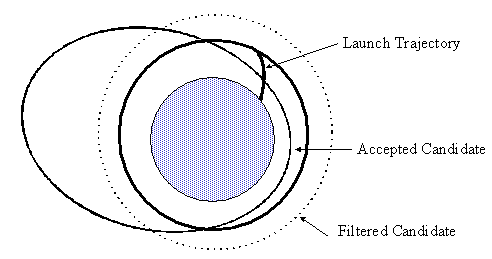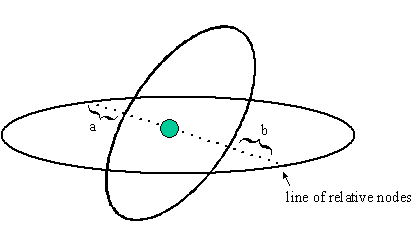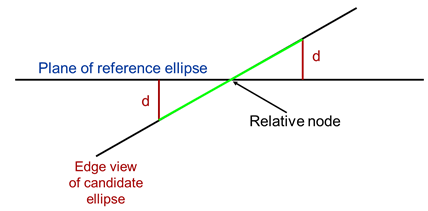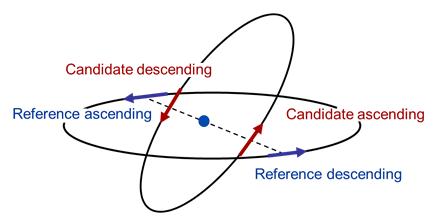CAT Advanced Options
Use the Advanced... button to specify the Satellite Database to be searched and to set other limitations and graphics display parameters. By default, the Close Approach Tool searches the stkAllTLE Satellite Database. To change the external file of GP data, enter the new file name and path in the
File Name field or click ![]() to browse for a GP data file.
to browse for a GP data file.
Select Cross Reference to report conjunctions using the Common Name for satellites. In the Cross Ref Name field, select a relatively comprehensive database file (such as stkAllTLE.sd) by entering the name and path or by clicking ![]() to browse to one. When the Close Approach Tool finds a close approach candidate in the external GP data file, it checks the cross reference file for a corresponding entry. If there is one, and the Add Conjuncting Satellites option has been selected, the satellite is brought into the scenario under its common name. And information is entered on the Description page of the Basic properties for that satellite. Otherwise, the satellite is brought in under its SSC number.
to browse to one. When the Close Approach Tool finds a close approach candidate in the external GP data file, it checks the cross reference file for a corresponding entry. If there is one, and the Add Conjuncting Satellites option has been selected, the satellite is brought into the scenario under its common name. And information is entered on the Description page of the Basic properties for that satellite. Otherwise, the satellite is brought in under its SSC number.
Using Pre-Filters
The basic idea behind close approach processing is to start with all catalogued orbiting objects and efficiently cut members of the population that do not come within the specified distance of the reference object. The basic approach consists of first eliminating as many members of the population as possible via geometric properties, which takes considerably less time than fully propagating these satellites and then computing close approaches. The final determination of the existence of close approaches is always done by sampling the ephemeris of the candidate and reference objects, but some set of pre-filters is usually applied to limit the amount of ephemeris generation that is required.
Several pre-filters are available as part of Close Approach processing. These filters are computationally inexpensive methods for limiting the number of objects and the periods of time for which brute force searching is needed. The proper use of the pre-filters can greatly reduce the amount of time needed for close approach processing.
Out of Date Pre-Filter
The out of date pre-filter allows you to determine how STK's Conjunction Analysis (CAT) capability will handle two-line element sets with epoch dates that do not fall within the time frame chosen for the close approach analysis. If this pre-filter is not selected, then out-of-date TLEs will not be excluded from the analysis. If the pre-filter is selected, then it will exclude any TLE whose epoch date precedes the beginning, or follows the end, of the analysis period by the amount of time specified in the Pad. The Pad currently defaults to 30 days.
Apogee/Perigee Pre-Filter
The apogee/perigee pre-filter is used to cut candidate close approach objects having a range of altitude that does not overlap with that of the reference object. This filter is always available.

Apogee/perigee pre-filter
Orbit Path Pre-Filter
The orbit path pre-filter is used to cut any candidate object whose orbital path does not come within a specified distance of the orbital path of the reference satellite. This filter does not consider the position of the satellites at specific points in time; only the paths in inertial space are used.

Orbit path pre-filter
In the above figure, assume that one of the ellipses represents the reference object and the other represents a candidate close approach object. The candidate passes the test only if the shorter of the distances a and b is less than or equal to the minimum allowable distance (i.e., the Threshold set in the Close Approach window). This filter is available only for satellites and should not be used if the ephemeris of the reference object contains orbit maneuvers.
In rare circumstances, the orbit path filter improperly removes a secondary that has a conjunction with the primary. For the highest accuracy results, do not use the filter without first investigating its behavior for the objects being considered.
Time Pre-Filter
The goal of the time filter is to identify time intervals when each object in a pairing is close enough to the elliptical representation of the other objects trajectory to have a conjunction. The actual metric computed is the distance of the reference object from the orbit plane of the candidate object, see the diagram below. Since this distance is always guaranteed to be less than the actual distance between objects, the metric is a conservative proxy for the separation distance. This filter works on the premise that both objects have to be in the right place at the right time for a conjunction to occur.

Distance from Primary to Orbit Plane of Secondary
Intervals are generated for each object independently and are anchored to the relative node between the two orbits. The condition for a possible conjunction is that an interval around the relative ascending node for the reference object overlaps with an interval around the relative descending node for the candidate object or visa versa. Like the orbit path filter, the time filter is limited to cases where the trajectories are not coplanar and neither object is maneuvering.

Relative Node Crossings
Pairings are eliminated from further consideration when there is no overlap between the intervals associated with the reference object and those associated with the candidate object. If a pairing does pass through this filter, the amount of time over which more detailed event detection must be is typically limited to a fairly small number of relatively short intervals.

Time pre-filter (intervals near relative node)
Filter Pads
The pads associated with each of the pre-filters are used to compensate for the fact that simplified models of the trajectories of the reference and candidate objects are used in the pre-filters. Most notably, the periodic variations in the orbital elements are not considered. The pads show increases in the minimum allowable distance -- implemented via the Max Range constraint -- which are applied at each stage of filtering. For example, if the Max Range constraint is set to 10 km and the apogee/perigee pre-filter has a pad of 30 km, then all candidate objects that come within 40 km of an altitude overlap with the reference object are retained for further processing.
The default pads of 30 km on each filter (30 days on the out of date filter) are usually enough for normal processing of close approaches in a time range of three days from the epoch of the elements in the Satellite Database. It may be necessary to use slightly larger pads on longer processing intervals.
The accuracy of close approach determinations decreases with the time from the epoch of the element sets. In general, close approach predictions more than five days in the future should be considered as suspect.
Adding Conjuncting Satellites to the Scenario
Conjuncting satellites, i.e. candidate satellites that closely approach the reference vehicle, can be added to the STK scenario. Simply select the appropriate option, enter the Maximum Number of satellites to be added and Set the Satellite Model Scale for the conjucting satellites.
Setting a maximum is advisable, since, depending on the number of orbiting objects in the database, the value entered for Maximum Range and the filter settings, the number of close approaches can be extremely high, reaching into the thousands. Setting a maximum prevents excessive memory use and a degradation of performance as STK propagates each added satellite and displays its ephemeris in the 2D Graphics window.
Displaying Access Graphics
You can also set Access Graphics to display in the 2D Graphics window once results have been tabulated. Choose to display Show Line, Animate Highlight and Static Highlight.